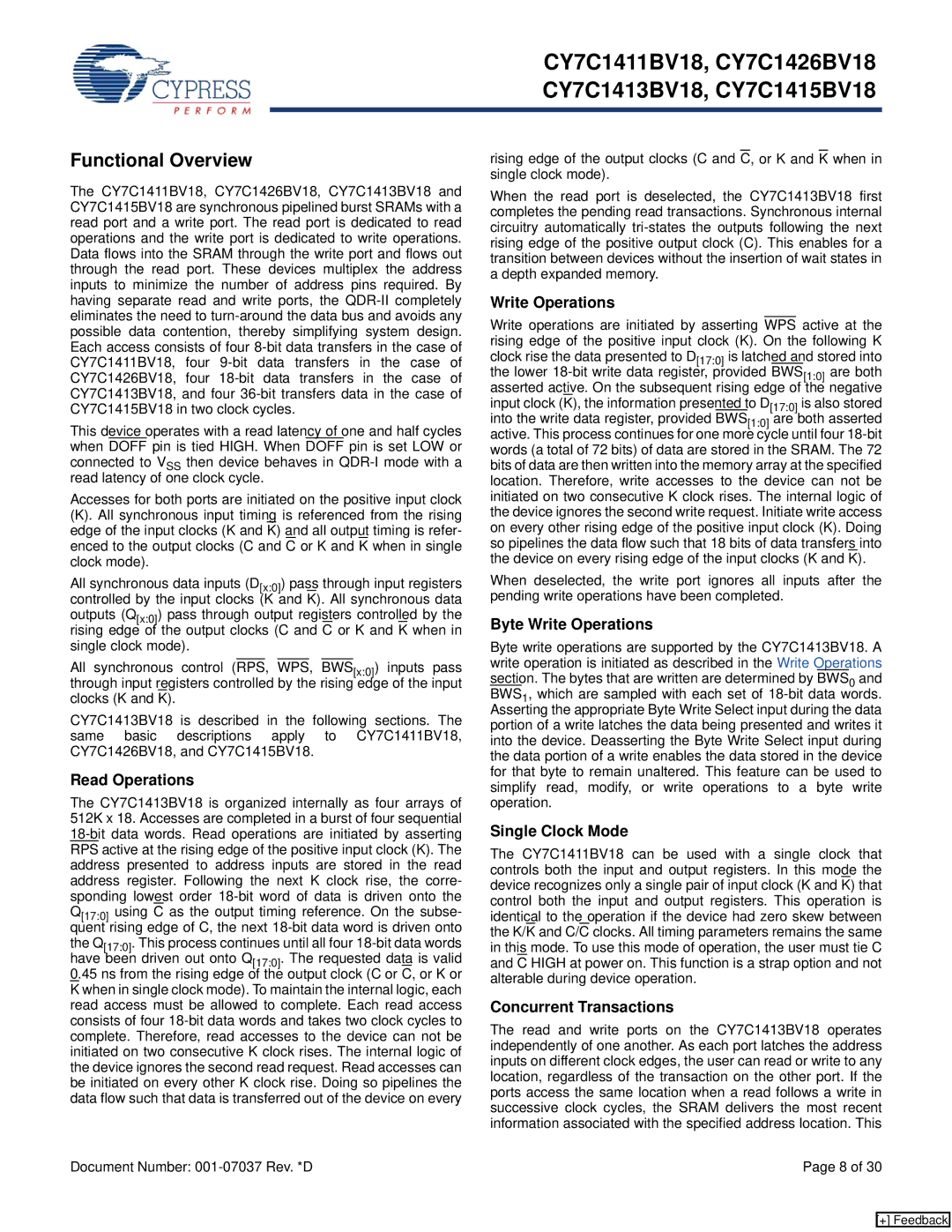
CY7C1411BV18, CY7C1426BV18 CY7C1413BV18, CY7C1415BV18
Functional Overview
The CY7C1411BV18, CY7C1426BV18, CY7C1413BV18 and CY7C1415BV18 are synchronous pipelined burst SRAMs with a read port and a write port. The read port is dedicated to read operations and the write port is dedicated to write operations. Data flows into the SRAM through the write port and flows out through the read port. These devices multiplex the address inputs to minimize the number of address pins required. By having separate read and write ports, the
This device operates with a read latency of one and half cycles when DOFF pin is tied HIGH. When DOFF pin is set LOW or connected to VSS then device behaves in
Accesses for both ports are initiated on the positive input clock
(K). All synchronous input timing is referenced from the rising edge of the input clocks (K and K) and all output timing is refer- enced to the output clocks (C and C or K and K when in single clock mode).
All synchronous data inputs (D[x:0]) pass through input registers controlled by the input clocks (K and K). All synchronous data outputs (Q[x:0]) pass through output registers controlled by the rising edge of the output clocks (C and C or K and K when in single clock mode).
All synchronous control (RPS, WPS, BWS[x:0]) inputs pass through input registers controlled by the rising edge of the input clocks (K and K).
CY7C1413BV18 is described in the following sections. The same basic descriptions apply to CY7C1411BV18, CY7C1426BV18, and CY7C1415BV18.
Read Operations
The CY7C1413BV18 is organized internally as four arrays of 512K x 18. Accesses are completed in a burst of four sequential
rising edge of the output clocks (C and C, or K and K when in single clock mode).
When the read port is deselected, the CY7C1413BV18 first completes the pending read transactions. Synchronous internal circuitry automatically
Write Operations
Write operations are initiated by asserting WPS active at the rising edge of the positive input clock (K). On the following K clock rise the data presented to D[17:0] is latched and stored into the lower
When deselected, the write port ignores all inputs after the pending write operations have been completed.
Byte Write Operations
Byte write operations are supported by the CY7C1413BV18. A write operation is initiated as described in the Write Operations section. The bytes that are written are determined by BWS0 and BWS1, which are sampled with each set of
Single Clock Mode
The CY7C1411BV18 can be used with a single clock that controls both the input and output registers. In this mode the device recognizes only a single pair of input clock (K and K) that control both the input and output registers. This operation is identical to the operation if the device had zero skew between the K/K and C/C clocks. All timing parameters remains the same in this mode. To use this mode of operation, the user must tie C and C HIGH at power on. This function is a strap option and not alterable during device operation.
Concurrent Transactions
The read and write ports on the CY7C1413BV18 operates independently of one another. As each port latches the address inputs on different clock edges, the user can read or write to any location, regardless of the transaction on the other port. If the ports access the same location when a read follows a write in successive clock cycles, the SRAM delivers the most recent information associated with the specified address location. This
Document Number: | Page 8 of 30 |
[+] Feedback
